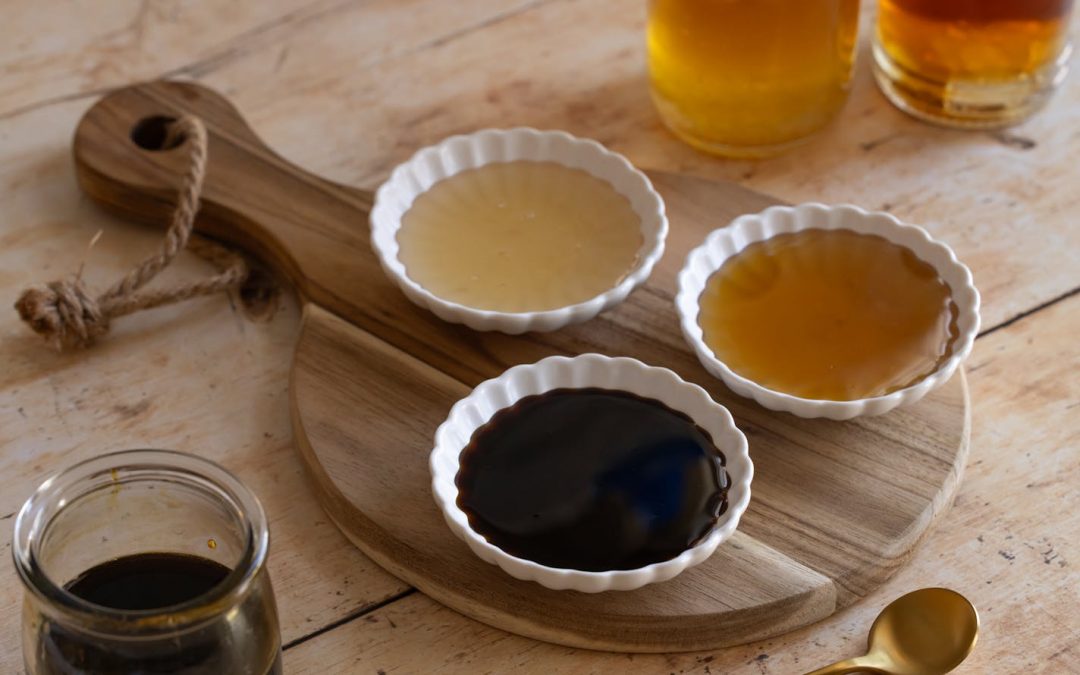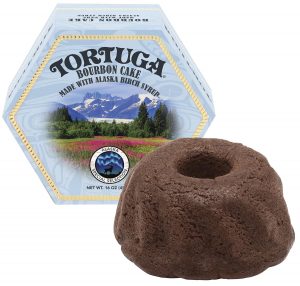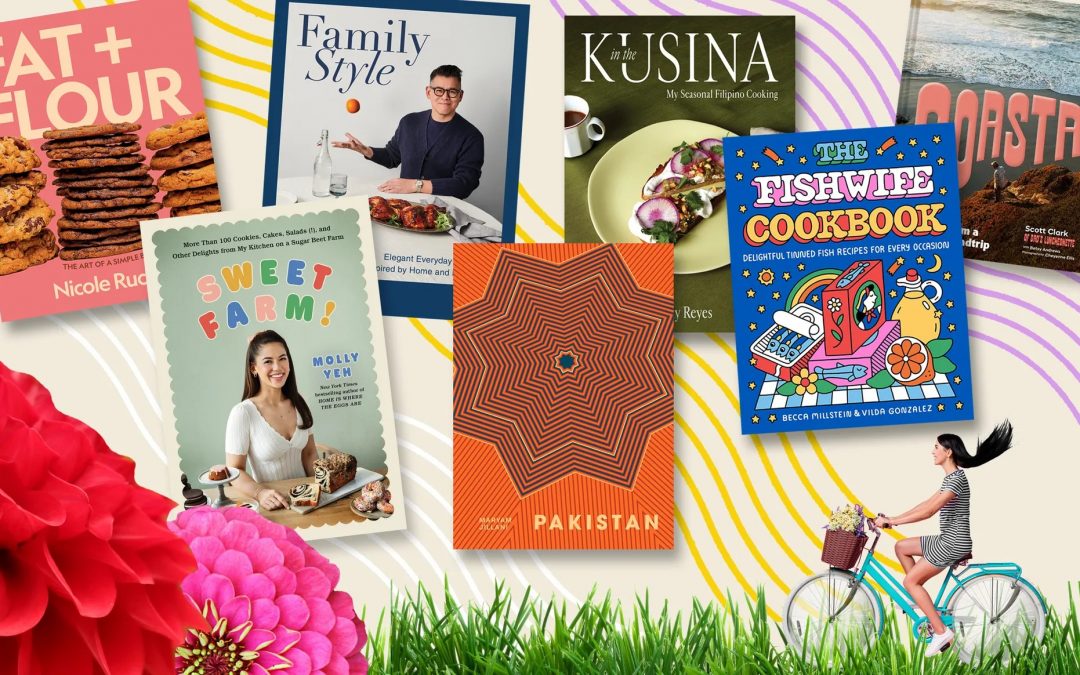Fishing out our favorites is always a painstaking but enjoyable task, and this was certainly the case with the following 20 titles. They include highly personal explorations of Pakistani and West African cuisines; a rollicking California road trip; an ode to third culture cooking; a seasonal, vegetable-forward take on Filipino food; smart and wildly creative ways to level up your baking; a paean to tinned fish; and the return of a beloved cookbook author. Taken as a whole, they make an exceptional life raft, one that will not only keep you afloat but also set you on a course for new and welcome adventures. — Rebecca Flint Marx
…
Becca Millstein and Vilda Gonzalez
HarperCollins, out now
The appeal of tinned fish lies in its shelf-stable convenience and ease: Pop it open and mix it with mayo for a sandwich, put it atop a cracker, or just eat it straight out of the can. So do we really need a cookbook dedicated to something that’s not supposed to require much… cooking? The Fishwife Cookbook makes the case that we do, much in the way its namesake brand has made the case for premium tinned fish sold in eye-catching illustrated boxes. Written by Fishwife co-founder Becca Millstein and recipe developer Vilda Gonzalez, it’s an approachable book that provides plenty of creative ways for rethinking tinned fish, from a quick meal of radish, butter, and anchovies on toast to more involved dishes like sardine and pesto pasta and a smoked salmon chowder.
The cookbook truly clicked for me in its cocktail party section, which inspired me to use tinned fish as an easy yet impressive way to feed a group.Brining anchovies in vodka and using the leftover anchovy oil to infuse the spirit for a martini is inspired, and the salmon and lemon creme fraiche dip I whipped up was far more impressive than stirring ranch powder into sour cream for the same amount of work. A friend brought over the crispy potatoes with herbed yogurt and tinned trout, which was devoured in minutes. One note: Since tinned fish can throw off the salt level, particularly in dishes you’re used to cooking, I recommend tasting often and erring on the side of lighter seasoning until the seafood is incorporated. But overall, this is a fun, playful cookbook, and you’ll get the same joy seeing its spine on your bookshelf as you do seeing a Fishwife box in your pantry. And if you need to substitute a more generic grocery store brand? We promise not to tell. — Stephanie Wu
…
Molly Yeh
William Morrow, out now
Molly Yeh’s third cookbook, Sweet Farm, has everything you’d want in a Molly Yeh cookbook. It is colorful and playful like Yeh herself, but full of thoughtfully produced dessert recipes that celebrate Midwestern culture, as well as Yeh’s Jewish and Chinese background and her husband’s Scandinavian roots. When you consider the fact that Yeh lives on a sugar beet farm, and has always been vocal about her obsession with sweets, it’s hard to believe it’s taken her this long to produce a cookbook solely focused on her passion for sugary treats. In its pages you’ll find recipes for classics like cardamom buns and sprinkle cake donuts, along with originals like a take on the Fig Newton with red bean, black sesame babka, and challah hotteok. There’s also an entire chapter devoted to Midwestern dessert salads, including a version of Minnesota’s controversial grape salad (a recipe that should be attempted and tasted before being judged because Yeh’s take, with thinly sliced grapes, is a work of art). It also wouldn’t be a Molly Yeh cookbook without plenty of marzipan, tahini, and coconut, so if you’re one for nutty flavors, especially in desserts, then Yeh’s latest should not be skipped. — Kat Thompson
…
Marie Mitchell
W.W. Norton, out now
There are some cookbooks that make you feel like you’re in the kitchen with the author. Such is the case with Marie Mitchell’s Kin, a compelling ode to the diverse recipes and culinary bounties of the Caribbean. Mitchell, who is based in the United Kingdom, weaves personal essays from her Jamaican heritage and influences from the region’s surrounding countries — sharing memories of her wedding in Grenada and of the last trip she took there with her mother — documenting generations of cuisine and the emotions the food evokes. There are many traditional offerings here: Jamaican patties with chicken or vegetables, plantain chips, and rice and peas all have a prominent place. Equally notable are Mitchell’s spicy interpretations of mango chutney, ackee and saltfish fritters served in pattie pastry cups, and a zippy pickled spring onion sauce with a generous heaping of mustard seeds. The sauce paired well with the author’s pepper prawns, as well as every other rice and fish dish I found myself adding it to throughout the week. And be sure to indulge in the desserts chapter, where you’ll find poached pears, stout punch ice cream infused with Guinness, and sweet potato pudding, delectable bites of the region’s varied offerings. — Kayla Stewart
…
Scott Clark with Betsy Andrews
Chronicle Books, out now
“I cook in a rented caboose on the side of the highway,” Scott Clark writes in Coastal. It’s a declaration of truth, but not the whole truth: Dad’s Luncheonette, his Half Moon Bay, California, restaurant, sits on a stretch of the mythical Pacific Coast Highway, and the exuberant food that comes out of his tiny kitchen belies its humble surroundings. Clark is a former chef de cuisine at San Francisco’s Michelin-starred Saison, and it shows: While his food isn’t fancy, it betrays considerable care and technique.
So it follows that the chef’s first cookbook (written with Betsy Andrews) pays homage not only to California’s Central Coast but also the little details that give his food such verve. Framed as a road trip down PCH, it’s packed with the kind of recipes that invite California dreaming: think Dungeness crab rice, chicken-fried morels with red-eye gravy, kale salad with candied kumquats and toasted buckwheat groats. It’s food that’s hearty, gorgeous, and a little bit wild.
I went straight for the hen-of-the-woods sandwich, which I’d devoured a few times at Dad’s. As at the restaurant, it’s a simple, rewarding affair: Mushrooms are pan-fried with a slice of cheddar and an egg, then plopped on toasted bread with a slathering of Dad Sauce, a ruinously delicious mayonnaise riff. Clark’s CA Muddy Buddies, a twist on the classic Chex snack, didn’t work quite as well for me — its method for melting-slash-browning the white chocolate yielded white chocolate pebbles — but I still got something worth eating by the handful. As I stuffed my face, I felt happy knowing that even if I can’t make it back to Dad’s anytime soon, I can take a literal page from its playbook and wind up with (to paraphrase Clark) a damned fine meal I made myself. — Rebecca Flint Marx
…
Eric Adjepong with Korsha Wilson
Clarkson Potter, March 11
On Top Chef: Kentucky’s 2018 finale, Eric Adjepong cooked a meal he hoped would “tell the story of the Transatlantic Slave Trade and how those flavors migrated to the South.” He was eliminated after the first course. But his new book, Ghana to the World, continues the narrative. Written with Korsha Wilson, it joins a handful of fine dining establishments, as well as books like My Everyday Lagos and In Bibi’s Kitchen, in giving West African food its due spotlight in America, highlighting its history as the backbone of so many American and Caribbean staples, and the variety of deep flavors still unfamiliar to so many.
As many cookbook authors do nowadays, Adjepong rejects the authoritative for the personal, insisting upfront he speaks only for himself. “The recipes here are dishes you can enjoy,” he writes, “but they’re also stories about how I got creative with the food I grew up with and incorporated things I’ve seen, learned, and tasted … making dishes that are true to their essence while also reflecting my own story as a Ghanaian American.” He even notes which dishes are more modern and which are more traditional with different symbols: a nea onnim for the former, a sankofa, a bird facing backward but flying forward, for the latter.
You’ll find Adjepong’s take on his aunt’s stewed turkey wings, rich with brown sugar and thyme, and glazed carrots with benne seeds, alongside more traditional recipes for kelewele and palm nut soup. And of course there’s his family’s version of jollof rice, a dish that there are more versions of than there are people. Adjepong’s is packed with tomatoes, curry powder, and Maggi seasoning, at once authentic and personal. His book shows the divide between the two is never that big. — Jaya Saxena
…
Calvin Eng with Phoebe Melnick
Clarkson Potter, March 18
If an egg is a litmus test for a chef’s caliber in a professional kitchen, can an egg recipe be the same for a cookbook? Having cooked Calvin Eng’s extra-plush Hong Kong egg scramble, I’m going to say yes. Paired with his taro-root diner hash browns with sweet-and-spicy ketchup, they were unassuming in concept but over-delivered in satisfaction. I often make hash browns and scrambled eggs, but these recipes offered me easy ways to play with both. The key to the egg was just a little cornstarch, evaporated milk, oil, and water, a technique I’ll certainly continue to use, especially when I want a fluffy but stable scramble.
In general, my takeaway from the whole book was that Eng has plenty of approachable ideas to make familiar dishes better or more interesting. Eng, who quickly made a name for himself when he opened Bonnie’s, a Brooklyn Cantonese American restaurant, in 2022, offers recipes that rely on known techniques and dishes, but with clever tweaks and flavor upgrades. Shrimp-paste butter takes charred cabbage to another level. Salt and pepper seasoning and a side of Chinese ranch make pork schnitzel newly interesting. And plenty of people know about the magic of silken tofu zhuzhed with soy sauce and chile crisp, but what about a quick beefy black bean garlic sauce?
Some dishes might be familiar from Cantonese restaurants or the Bonnie’s menu, like the string beans with fermented fuyu butter, which are my personal favorite. But the key to the book’s subheading — and point of view — is “home” and not “restaurant.” Some chef-authored cookbooks feel fussy in a way that’s ultimately unfriendly to cooking at home, but Salt Sugar MSG feels cheffy in a more accessible way. You’ll be proud of yourself after making an Eng recipe, and pleasantly surprised by how chill it was to get there. — Bettina Makalintal
…
Peter Som
Harvest, March 18
It is obvious that Peter Som comes from a fashion background because each recipe in his debut cookbook incorporates robust creativity and is presented beautifully. But Family Style is not a book of style over substance: Most of the recipes are tethered to Som’s Chinese heritage, and although he reimagines dishes with flair, they actually work. Such is the case with Som’s crispy tofu paired with an herby scallion pesto, charred carrots glazed in a sticky-sweet gochujang honey butter, and a decadent interpretation of Hong Kong French toast that swaps the traditional peanut butter center for gooey cheese. The dishes feel familiar, but Som’s unique artistic liberties also make them excitingly new. While there is something for everyone in Family Style, it feels especially pertinent to home cooks who love a twist on classics. — KT
…
Maryam Jillani
Hardie Grant, March 25
If, like me, your eyes light up at a cookbook that devotes so many of its pages to contextualizing its recipes within their foodways of origin, Maryam Jillani’s Pakistan deserves a spot on your shelf. This approach is particularly valuable with Pakistani cuisine: As Jillani notes, the gastronomic traditions of her home country are often corralled into a monolith that also includes the vastness of Indian cooking. This does both cuisines and their regional specialties a disservice.
In Pakistan, Jillani takes an extremely personal approach to illuminating the extent and creativity of Pakistani cuisine, folding in childhood memories, snippets from conversations with friends, and scene-setting depictions of just how resourceful and generous Pakistani hospitality is. Punctuating the book with a region-by-region overview, she touches on how neighboring countries, conflict, and the forces of economic globalization have all played a role in shaping Pakistan’s cuisine.
Alongside perhaps more widely recognizable foods like mutton korma, aloo tikki, and sarson ka saag sit dishes that speak to the diversity of Pakistani food. There’s nihari, the brothy, punchy mutton stew hailing from Delhi, that in Pakistan is made with beef shank. And mamtu, Hunza-style chicken dumplings that are a likely cousin of Uyghur manti. There’s Afghan pulao with its fragrant raisin- and carrot-studded rice, a result of Pakistan’s influx of Afghani refugees in the ’80s. And patrani machhi, the Parsi fish dish wrapped in banana leaf and steamed with coconut chutney and coriander, which traveled alongside this ethno-religious group’s migration to India from Persia. Pakistan’s sweets section is likewise full of recipes that speak to the influence of Portuguese, British, and German trade routes, with custards, cakes, and trifles alongside sweetened rice and fruit-based dishes. Not only a tool for inspiration in the kitchen, Pakistan serves as a reminder that things are often far more beautifully complex than they may seem. — Nat Belkov
…
Beejhy Barhany with Elisa Ung
Knopf, April 1
Carl Sagan famously told viewers in Cosmos, “If you want to make an apple pie from scratch, you must first invent the universe.” I’m a little closer to understanding him after cooking the Shabbat fish stew out of Gursha, Beejhy Barhany’s book of recipes and stories about her family, her Beta Israel Ethiopian Jewish community, and her Harlem restaurant, Tsion Cafe. The stew required me to first make niter kibbeh, a spiced compound butter, and kulet, the stew base that’s fundamental to Ethiopian dishes like doro wat, which in turn required I make a berbere spice blend, which in turn required me to source a few Ethiopian ingredients. These recipes, nested like dolls, create a learning curve for unfamiliar home cooks, but once surmounted, they provide big rewards: Barhany writes her base recipes in massive quantities, which left me with enough kulet to make various stews with meat and beans all week.
The layered recipes also neatly reflect the layers of Barhany’s own story, which she unfurls in the book: her youth in Ethiopia’s Tigray region, her family’s flight from political violence in 1980, their time as refugees in Sudan, their aliyah to Israel, and her eventual move to New York. The foods that sustained the chef throughout her personal journey (and now bring in customers at Tsion Cafe) are interwoven with Barhany’s odes to family members who transmitted culinary traditions and influenced her cooking. Reading and cooking through the book is like constructing her universe from scratch. — Nick Mancall-Bitel
…
Meera Sodha
Flatiron Books, April 1
For me, a new Meera Sodha cookbook is like a new Nicole Holofcener movie: an occasion I eagerly await and make plans to enjoy as soon as possible. Dinner is Sodha’s fourth cookbook, and her first in five years. It marks a triumphant return in more ways than one: “A couple of years ago,” Sodha writes, “I lost my love for food. I didn’t want to shop. I didn’t want to cook. I ate for necessity, not pleasure.” It took months for her to find her way back, and when she did, it was through the act of making dinner for her family, rather than cooking in constant pursuit of new dishes and ideas.
Sodha’s focus on dinner is a gift for home cooks like me, who similarly view dinner as the most important meal of the day but sometimes run out of ways to keep the spark alive.If I cooked from this book alone for the next year, I doubt I’d ever get bored. Sodha orders it by ingredient but provides alternate tables of contents that group the recipes by season, dish category, and degree of preparation (Quick, Bung It in the Oven, Curries). As an eggplant fiend, I first gravitated towards her recipe for miso eggplants with salt and vinegar kale, then made my way to her tofu, coconut, and green bean curry and her miso butter greens pasta. The latter picks up where Joshua McFadden’s famous kale sauce left off, sauteing the kale in butter with some broccoli, fennel seeds, and chile flakes, then pureeing it with miso into something even more luxurious than its inspiration. Every recipe I tried was simple in execution and complex in flavor and texture, the kind of straightforward, satisfying cooking I’ll return to as often as possible. Welcome back, Meera. We’re glad you’re here. — RFM
…
Zaynab Issa
Abrams, April 1
The term “third culture kid” was originally coined in the 1950s by the professors John and Ruth Hill Useem, who were studying children living in expat communities. They observed that the children’s behaviors and cultural norms did not align with those of their country of origin, nor necessarily with those of the country they were living in. Instead, there was a third culture, or really, a melding of cultures and norms by those who grew up in between them.
“America itself is a third culture nation; especially considering many of us who’ve ended up here and planted roots can’t actually trace our bloodline to this land,” writes Zaynab Issa, former associate food editor at Bon Appétit. “Most of us have a story of migration — if not you, then maybe your great-great-grandparents, but this reality remains: The culture of your homeland has mixed with the culture of others here, creating an entirely new one.” Third Culture Cooking is her ode to her own specific third culture — influenced by her Tanzanian and Indian family — Bushwick restaurants she misses, and flavors she just likes even if there is no obvious biographical connection.
Issa’s recipes are mashups of everything you’d want to eat, like red curry orzotto (an easier risotto made with orzo), or coconutty corn inspired by East African makai paka. But what makes the book genius is her guide to cooking through it, separated by mood, cooking time, and menu. Feeling lazy and have an hour? Try the tortellini en preserved lemon brodo. In the mood for something more fun? Make the maple za’atar kettle corn. Planning a brunch? Make Turkish-ish eggs and baklava granola. Issa’s approach makes cooking feel more like a choose-your-own-adventure. But as all third culture kids know, it always was. —JS
…
Georgia Freedman
Hardie Grant, April 8
The recipes in writer Georgia Freedman’s Snacking Dinners are mostly focused on assembling a bunch of really great ingredients, and that’s by design. The book describes these “snacking dinners” as both “low-lift, high reward” and “the ultimate form of self-care,” and it’s not wrong. It’s wildly simple to arrange frozen Tater Tots, crisped in the oven, on a plate, then shower them in classic okonomiyaki toppings for a dinner that takes about 20 minutes to prepare, but also seems like it could’ve been served at your favorite hip neighborhood restaurant.
Freedman’s inclusion of an entire section on creative toasts, which are often where my mind goes when I’m too lazy or tired to even think about dirtying a bunch of pots and pans, is especially compelling. Her book’s salami and white bean toast is an instant addition to my lazy-dinner repertoire, even though it doesn’t taste lazy at all, and I eagerly await the opportunity to make Freedman’s pimento cheese and tomato finger sandwiches during peak tomato season. My one minor quibble with Snacking Dinners is that its recipes require a pretty well-stocked pantry — I didn’t have okonomiyaki sauce for the tots, for example — and I would’ve appreciated a little more detail on what to substitute (or, even better, how to make it myself). Ultimately, though, Freedman’s recipes feel like a really fresh update to what some might call “girl dinner” — instead of subsisting on multiple handfuls of popcorn, you can now reach for an upgrade. — Amy McCarthy
…
Nicole Rucker
Knopf, April 8
I have to admit that I went into Los Angeles pastry chef Nicole Rucker’s new cookbook with a whole lot of skepticism. I was skeptical of her “Cold Butter Method,” in which she incorporates the butter in her cookie recipes into dry flour instead of using the traditional method of creaming butter and sugar together — until it produced the fluffiest, chewiest snickerdoodles I’d ever baked. Rucker’s second cookbook is positively replete with classic desserts — vegan chocolate cream pie, sunken fruit cake, and high-protein banana bread among them — that make use of counterintuitive techniques and lessons learned from a long career in the pastry kitchen, and they’re all worth a try.
I was also skeptical that Rucker’s unique recipe for London Fog brownies, in which white chocolate is whipped into a fluffy, tea-infused base and nearly a full cup of chopped dark chocolate is scattered on top, would work out. But they were a revelation, complex and full of flavor and boasting a dreamily tender texture. Rucker’s book repeatedly proved that my skepticism in her unconventional wisdom was totally misplaced. If, like me, you just trust her, you’ll produce some incredibly compelling bakes. — AM
…
Woldy Reyes and Fujio Emura
Chronicle, April 8
Filipino food is not often described as light, which you might chalk up to the fact that many of our most famous dishes, especially abroad, are meat-centric celebration foods. The New York City-based chef Woldy Reyes, however, is known for his refreshingly light, vegetable-forward approach to Filipino flavors and cuisine. He employs lots of fresh herbs, crunchy vegetables, and creamy, often coconut-based sauces in the catering that he does for stylish brands and events.
In this, Reyes’s debut cookbook, he offers recipes and tips for bringing his approach into your home kitchen — a perspective that I think will give exciting new insight to both pre-existing fans of Filipino food and people who love fresh, seasonal vegetables and want ways to work with them. I found Reyes’s vegetarian riff on bagoong, the fermented Filipino seafood paste, particularly illuminating: Reyes makes it with slow-cooked garlic, porcini mushroom powder, and coconut jam, and then uses it to fortify a coconut milk-based spaghetti sauce or serve as a dip for crudites. As many cookbooks do, Reyes takes a flexible approach to eating mostly vegetables: There is no meat or seafood here, but he does occasionally call for fish sauce.
Reyes’s book is structured around seasonal produce and he uses it well. Filipino spaghetti — usually a meaty, heavy dish — has the requisite banana ketchup, but burst cherry tomatoes give it levity and natural sweetness. Depending on the time of year, Reyes’s lumpia is made with chickpeas, asparagus, or kabocha squash that’s flavored with spicy miso. And instead of braising green beans to make adobo, he chars them on a grill and finishes them with adobo vinaigrette. Reyes might be taking Filipino food in a lighter direction than what many of us are familiar with, but throughout In the Kusina, he proves that this doesn’t have to come at the expense of big, bold flavors. — BM
…
The Silver Spoon Kitchen
Phaidon, April 10
Tradition taught by way of regional variances takes the lead in the Silver Spoon’s Regional Italian Cookbook, where early sections like “Italy is Pasta,” assure the reader that they’re up for a master class in the inner workings of a proper Italian recipe collection — with soft images to place you in the lush European country to boot. A journey through Sicily and Italy’s north, south, and center are accompanied by flavor guides defined by region, and the recipes that have endured within them for generations. For a comforting weeknight dinner, I recommend perusing recipes found in the country’s south, preserved in regions like Molise, Campania, Puglia, Calabria, Basilicata, and Abruzzo, where “cooking is what it used to be,” and regional tradition is repeated in chitarra with meatballs and “the seven virtues” minestrone made with legumes found in the pantry during spring cleaning.
The cookbook has handy green symbols that indicate whether a recipe is vegetarian, vegan, gluten-, dairy-, or nut-free, making it easy for readers who follow alternative diets to find the dish that works for them. Among a wide selection of recipes that detail the variances of the country’s cuisine, you might consider an aromatic and indulgent saffron risotto inspired by the rich land of Lombardy, or sweet and sour sardines from Veneto. For a forthcoming celebration, I have my eye on an option that equally prioritizes beauty and taste: The Festive meringue cake, typically made on Good Friday and enjoyed on Easter Sunday, is dotted with colored sprinkles and appears worthy of the most jubilant gatherings. — KS
…
Hailee Catalano
DK/Penguin Random House, April 15
Hailee Catalano is one of my favorite cooking creators. Catalano’s restaurant background comes through in her technique and her recipes, which have sophisticated flourishes and a strong sense of self. The hallmarks of a “Cafe Hailee” dish? Pecorino Romano, Calabrian chiles, herbs, crunchy vegetables, basting, good bread. Catalano’s skill and sincerity come through in By Heart, a cookbook that feels neither showy nor trendy but timeless.
By Heart is made up of many recipes that I can see becoming staples in my cooking, like a creamy, spicy pasta sauce made of steamed-then-blended carrots; cumin lamb-inspired beets with cumin-seed butter, chile crisp, and black vinegar; and slow-roasted salmon with fennel two ways. I think a lot of cooks will have similar reactions to By Heart. Catalano excels at juxtaposition, often finishing a heavy or creamy dish with something tart, bright, or crunchy, which keeps her food interesting even many bites in (that carrot pasta, for example, calls for turning the carrot tops into a lemony finishing sauce).
There’s enough variation in By Heart that you could make this a cookbook that you work through for weeks, with chapters on snacks, pizza, sandwiches, sweets, and sourdough bread. In all, it’s a highly cookable book with recipes that’ll give you something to be excited about every season — fried squash blossom mozzarella sticks in the summer, pot roast au poivre with charred onions in the winter — and enough emphasis on technique and efficiency to make you feel like you’re becoming a better cook. — BM
…
Rawia Bishara
Interlink Books, April 22
In the heart of Brooklyn’s Bay Ridge is Tanoreen, Rawia and Jumana Bishara’s ode to their homeland of Palestine. The mother and daughter have become household names for their generous, cross-cultural menu, which is home to delicacies like lamb kibbeh, cheesy, sugary kanafeh, and a beautiful fried cauliflower steak. This expanded edition of Rawia’s first cookbook, Olives, Lemons and Za’atar, is published by Interlink Publishing, a Palestinian-owned publishing house based in Massachusetts. Its recipes detail Rawia’s upbringing in Nazareth and the lessons she picked up as she migrated to her present home in Brooklyn and built a community there. I was comforted in the early morning weekend hours by her take on meat and eggs: a creamy, gently spiced, brunch-friendly creation Rawia remembers her dad making on Saturday mornings. I enjoyed the earthy egg and lamb mixture as I read more about her culinary perspective, which takes inspiration from her Palestinian heritage and the friendships she’s cultivated across the Middle East. Important cooking tips lay within Bishara’s headnotes; she tells you, for example, how to ask a butcher to process a lamb leg, and which types of onions will work just right for Palestinian couscous, so do take heed of her guidance. — KS
…
Eden Grinshpan
Avery, April 22
A recipe developer-cum-lifestyle influencer in the mode of Alison Roman and Molly Baz, Eden Grinshpan first landed on the map with her Cooking Channel show Eden Eats, but grew a bigger following on Instagram. (She’s also the host of Top Chef Canada.) Now she’s out with her second cookbook, Tahini Baby, a vegetarian-by-accident volume dedicated to tahini and its sibling Middle Eastern ingredients. Like those published by Roman and Baz, the book leans on Grinshpan’s aspirational brand of laid-back cool-girl cooking, one that combines an approachable voice with a swoony sun-dappled aesthetic.
Yet for all the lifestyle-influencer clichés, Grinshpan has carved out her own space as the millennial cool girl of the Israeli Jewish culinary cinematic universe. Some home cooks will be familiar with — and perhaps initially unexcited by — what Tahini Baby seems to offer, with its takes on hummus, zhoug, toum, maqloubeh, and other Levantine staples. Like Jerusalem, Zahav, and Falastin before it, Tahini Baby calls upon ingredients like pomegranate molasses, sumac, za’atar, harissa, Aleppo pepper, and Grinshpan’s beloved tahini paste, to an almost repetitious degree.
But Grinshpan’srecipes— spread across a daunting 300+ pages — are genuinely good, bringing those well-loved ingredients together in new ways for delicious results. Grinshpan’s Moroccan harira soup is brighter and zestier than those with Moroccan grandmothers may expect, in a good way; her take on asparagus uses crispy za’atar oil, toasted walnuts, and a tangy tahini vinaigrette that elevates what could otherwise be a ho-hum veggie side dish.
Sometimes the simplicity of Grinshpan’s recipes is deceptive, with ingredient lists stretching to Ottolenghian lengths and recipe steps nested within other recipe steps; and sometimes the millennial food-speak can overwhelm (“garlicky,” “herby,” “tomatoey,” and even “pickle-y” make appearances). But for those who love Middle Eastern flavors and are running low on ideas for what to do with that harissa, zhoug, or tahini in the pantry, Tahini Baby is a fun, fresh, aesthetically pleasing entrant to the category. —Ellie Krupnick
…
Hawa Hassan
Ten Speed Press, May 13
In Hawa Hassan’s second book, the author and owner of Basbaas Foods takes readers on a journey through eight countries — Afghanistan, Democratic Republic of Congo, Egypt, El Salvador, Iraq, Lebanon, Liberia, and Yemen — impacted by war, displacement, resilience, and community preservation and development. It’s a structure similar to the one Hassan used in her first cookbook, the James Beard Award-winning In Bibi’s Kitchen, where she guided readers through eight African countries that touch the Indian Ocean through the lens of grandmothers.
In her sophomore work, Hassan leans on her own experience with displacement and migration, beginning with her origins as a four-year-old in war-torn Mogadishu, Somalia, and taking home cooks on a journey to her current home in Brooklyn. She pairs her own experiences traveling in each country with important historical context explaining their various internal conflicts. Along the way she meets a host of compelling individuals, including families, entrepreneurs, street vendors, and activists who offer superb recipes for dishes such as Afghan mantu stuffed with beef or lamb; madesu, a hearty stewed red bean dish from the Democratic Republic of Congo; and halabessa, a hot chickpea broth popular in Egypt that “lands somewhere between a soup and a drink.”
Hassan carries both the personal understanding of what many of her sources have experienced and the culinary expertise necessary to take home cooks on an emotional journey through the stories and recipes carried across home, border, and time. They add up to a flavorful compendium of global recipes, all of which illustrate the abundance found in countries that are far too often defined by horrors endured rather than beautiful histories, communities, and cuisines preserved. — KS
…
Casey Elsass
Union Square, May 20
For anyone who thinks pulling up to a gathering with just a bottle of wine or six-pack of beer is boring but doesn’t know what else to bring, Casey Elsass has answers — lots of them. His latest cookbook is broken up into eight sections with 75 recipes perfect for every type of party: late-night ragers (bring the cocktail Jell-O shots), a pleasant brunch with your book club (gochujang and cheddar scones are perfect in this scenario), an elegant dinner party (the lemon bar cake will wow here), and a game day tailgate (any dip in the dip section will do). What Can I Bring is a solo endeavor for Elsass, who has previously co-authored or ghostwritten over 20 cookbooks like Dolci! and Second Generation. With his experience as a cookbook veteran, Elsass ensures that his recipes are approachable — there’s even a cornbread where the batter is entirely made in a blender — but still possesses a wow factor that is sure to please a crowd. His book’s last chapter, Present Moment, is also all about homemade food and drink gifts (for the stubborn host who insists you don’t bring a plate). It features recipes for plum and walnut jam, hot fudge, and even oyster crackers. Perhaps the best gift, however, is a copy of the cookbook itself. — KT
Andrea D’Aquino is an illustrator and author based in New York City.
…

The Ultimate Minnesota Cookie Book: 100 Best Recipes from the Star Tribune’s Holiday Cookie Contest
…

















:no_upscale()/cdn.vox-cdn.com/uploads/chorus_asset/file/25892127/9780063382527_HC.jpg)
:no_upscale()/cdn.vox-cdn.com/uploads/chorus_asset/file/25892130/SweetFarm_HC.jpg)
:no_upscale()/cdn.vox-cdn.com/uploads/chorus_asset/file/25896807/image001.jpg)
:no_upscale()/cdn.vox-cdn.com/uploads/chorus_asset/file/25905571/Coastal_FinalCoverApproved_V3.jpg)
:no_upscale()/cdn.vox-cdn.com/uploads/chorus_asset/file/25892132/GhanaToTheWorld_Cover.jpg)
:no_upscale()/cdn.vox-cdn.com/uploads/chorus_asset/file/25892137/Salt_Sugar_MSG___Cover.jpg)
:no_upscale()/cdn.vox-cdn.com/uploads/chorus_asset/file/25892144/FamilyStyle_Credit_to_HarperCollins_Publishers.jpg)
:no_upscale()/cdn.vox-cdn.com/uploads/chorus_asset/file/25892151/Pakistan_Cover_Image.jpg)
:no_upscale()/cdn.vox-cdn.com/uploads/chorus_asset/file/25892153/Cover_Gursha.jpg)
:no_upscale()/cdn.vox-cdn.com/uploads/chorus_asset/file/25892158/Dinner_FC.jpg)
:no_upscale()/cdn.vox-cdn.com/uploads/chorus_asset/file/25892160/COVER_ThirdCultureCooking__1_.jpg)
:no_upscale()/cdn.vox-cdn.com/uploads/chorus_asset/file/25892163/SnackingDinners_Cover.jpg)
:no_upscale()/cdn.vox-cdn.com/uploads/chorus_asset/file/25892165/Cover_Fat_Flour.jpg)
:no_upscale()/cdn.vox-cdn.com/uploads/chorus_asset/file/25892172/IntheKusina_FinalCoverApprovedV2.jpg)
:no_upscale()/cdn.vox-cdn.com/uploads/chorus_asset/file/25897448/9780714849218__1_.jpg)
:no_upscale()/cdn.vox-cdn.com/uploads/chorus_asset/file/25892171/ByHeart_Cover_FINAL.jpg)
:no_upscale()/cdn.vox-cdn.com/uploads/chorus_asset/file/25892315/9781623716301.jpg)
:no_upscale()/cdn.vox-cdn.com/uploads/chorus_asset/file/25892175/Photo_Credit_Avery_Penguin_Random_House.jpg)
:no_upscale()/cdn.vox-cdn.com/uploads/chorus_asset/file/25892210/HASS_Setting_a_Place_for_Us_Cover_Front.jpg)
:no_upscale()/cdn.vox-cdn.com/uploads/chorus_asset/file/25892180/WCIB_Cover.jpg)
















